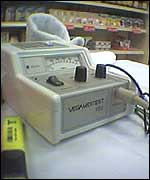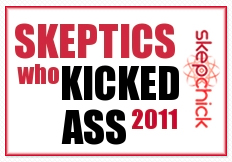I just had a call from my Mum who had been visiting a friend with cancer.
Despite several rounds of chemotherapy and the best treatment available, her cancer has not regressed and the future does not look good. So, understandably, she is desperate – just the type of person likely to fall victim to unconventional treatments. She has previously been a victim of hair analysis, where she was told tomatoes were the cause of her problems and she could drink gin but not red wine (ridiculous).
Tonight she had a new magic treatment to tell my Mum about – the Vega machine. This thing is so good it can analyse the type of bacteria in your gut by placing an electrode between the toes of your right foot. My Mum called me on the way home to ask me if it was BS. Of course, I strongly suspected immediately that it was, but to be sure in two clicks of a mouse and a 30 sec Google search I was found to be correct.

Vega - the biggest star in the constellation of Lyra. Unlike the Vega machine, a spectacular sight, not a spectacular rip-off.
What is the Vega machine or Vega test?
The apparatus consists of a box containing a galvanometer which compares the resistance between the skin in contact with a hand electrode and the skin tested with a measuring stylus. The other contents of the box are an electrical source. For a more thorough explanation of the electronics behind the Vega machine see here.
Proponents claim; “Over 120 substances which include common foods and drinks and environmental substances are tested during our consultation. The equipment we use is a bio-electronic analyzer which measures the body’s electrical resistance to these substances. If a substance is causing a problem then it there will be a dip or drop in body’s electrical resistance”.
Does it work? [NO]
A 2003 investigation by the BBC sent subjects to undergo Vega testing at different health food shops in the UK, and reported that test results varied from store to store. The report revealed that one subject was allergic to 33 different types of food, with only three being agreed upon by the testers across stores. Further, one reporter was told he needed to take a total of 20 different vitamins and minerals. But again, the testers couldn’t seem to agree and all three testers advised different supplements.
When the manufacturer, Health Screen International (HSL), were asked to explain themselves they said that the Vega machine is only about 70% accurate and “It does stretch the imagination how the Vega test works…But we have thousands of letters from people saying how much better they feel.”
Oh testimonials, of course. Any regular readers of this blog would know that testimonials do not constitute scientific evidence. The human mind is fallible, memories are remodelled and we sometimes inadvertently attribute an effect of one treatment when our body may have repaired itself naturally. Or we may have done something else to reverse the pain or illness. A red flag should always be raised if you come across a product or service that has no evidence for efficacy apart from testimonials. They are simply unreliable.
Even earlier than the 2003 BBC investigation, a paper was published in the Medical Journal of Australia, which concluded this:
Vega testing (the Vega test method) is an unorthodox method of diagnosing allergic and other diseases. It has no established scientific basis and there are no controlled trials to support its usefulness. Vega testing may lead to inappropriate treatment and expense to the patient and community (1).
And here’s what Quackwatch have to say about the likes of Vega test:
The devices described in this article are used to diagnose nonexistent health problems, select inappropriate treatment, and defraud insurance companies. The practitioners who use them are either delusional, dishonest, or both. These devices should be confiscated and the practitioners who use them should be prosecuted.
At sceptics in the pub on Thursday evening, someone asked me what motivates me to do this stuff, especially since, as he put it, it is largely a thankless task. Well, this is part of the reason. Quacks making a quick buck from sick, vulnerable and desperate individuals really gets my goat.
I know my Mum’s friend – she’s much too vulnerable for me to explain that she is getting scammed. I can only hope that by educating other people like you dear reader, that we can avoid more harm.
—————————-
Postscript: Upon reflection, doesn’t this sound quite a lot like the K-test, featured in LBC radio recently and criticised by Ben Goldacre on Bad Science? Whilst it’s not exactly the same, Kymatica still use the food allergy line, but claim to be able to tell the difference between allergies and resistance, which they explain with a lot of jargon about IgG and IgE antibodies. Ooooh, sciencey!
(1) C H Katelaris et al., Med J Aust 1991; 155: 113-114.
For the story of a nurse’s tale about debunking quack devices masquerading as medical diagnostics, see this article from the Skeptic.
Browse Timeline
- « How to get the Maternity Immunisation Allowance without getting your kids vaccinated.
- » Cosmetic ad banned for using “waffle” science






